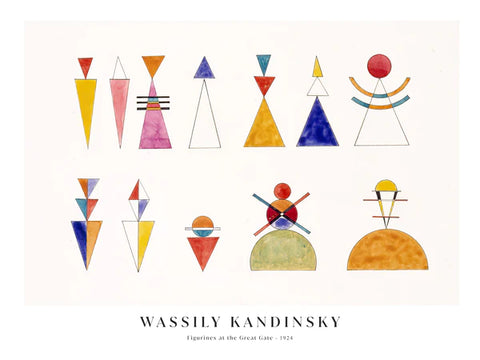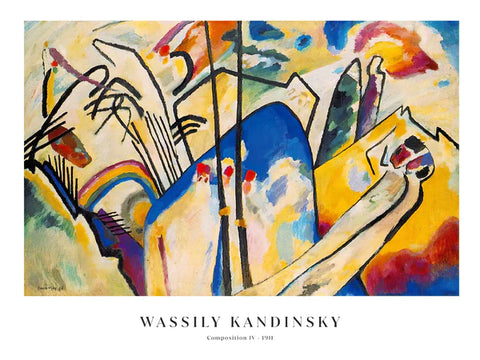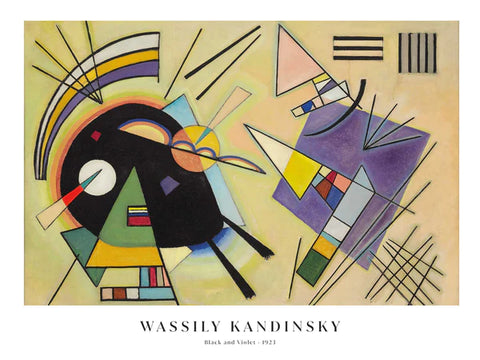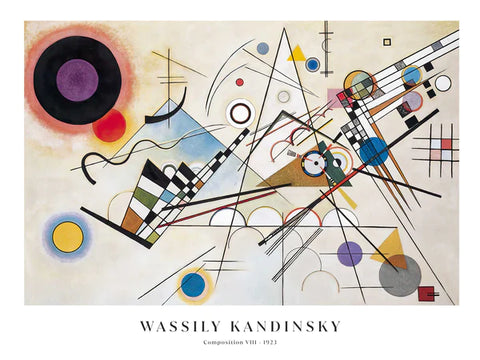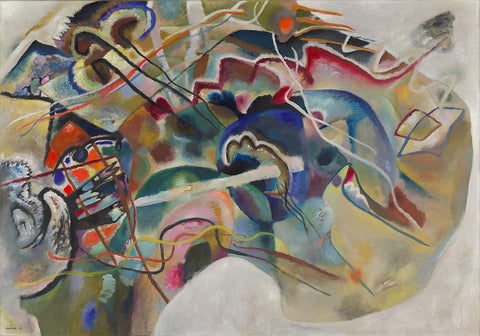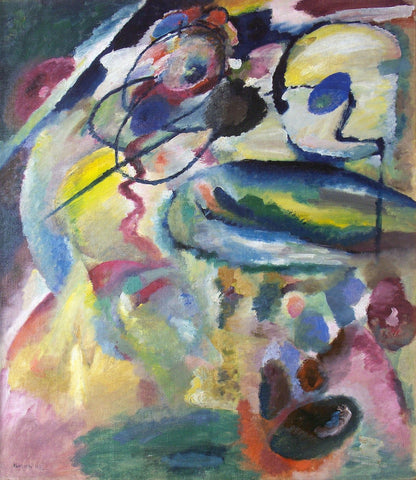10 Most Famous Paintings by Wassily Kandinsky
Introduction
Wassily Kandinsky was one of the most influential abstract painters of the 20th century. His paintings were both beautiful and revolutionary, with their use of vibrant colors and non-representational forms. They pushed artistic boundaries in ways that would later influence other artists such as Jackson Pollock and Mark Rothko. In this article we will discuss 10 of his most famous paintings, which range from early works to more mature pieces from his later years.
1. Figures at the great gate
The Figures at the great gate is a 1913 oil on canvas by Wassily Kandinsky. It is one of his most famous paintings and was part of a series of abstract works he produced in 1913.
The painting shows two people standing in front of a black and white door, with the heads cut off from view and painted blue-green. The figures are made up entirely of geometric shapes and lines, which create an almost mystical appearance for them.
This work is considered to be Kandinsky's first abstract painting, although it still contains some figurative elements such as heads, shoes, legs and hands. But these details are what makes this artwork so unique: nothing else could possibly resemble these figures except humans! The use of black lines helps define each form while depicting depth perception through negative space which also makes your eyes move around the painting without any difficulty at all!
2. Composition IV
Wassily Kandinsky's Composition IV is a painting that was created in 1910 by the famous Russian painter. It depicts a woman standing in the middle of an abstract field of color, with her back turned to us and her arms spread out as if she were embracing all that surrounds her.
This piece was done during what's known as Kandinsky's "Blue Rider" period. This movement focused heavily on spiritual and emotional messages conveyed through abstracted imagery, rather than trying to represent reality directly (which was common practice at the time). This piece takes its title from its composition: four figures arranged around each other in a circle (or square). The colors used throughout the work are mostly shades of blue, except for some lighter colors used here and there for contrast.
3. Composition VII
Composition VII is a painting by Wassily Kandinsky, the seventh in his series of abstract works with the same title. It was painted in 1923 and produced at a time when Kandinsky turned away from pure abstraction to focus on figurative work. The work is an oil painting on canvas with dimensions of 476 x 710 cm.
4. Black and Violet
The painting was created in 1911 and is oil on canvas. The work currently belongs to the collection of the Museum of Modern Art in New York City, where it is considered one of Kandinsky's most important works. The painting depicts the artist's wife, Nina Kandinsky (1884–1944), who wears a black dress with violet flowers.
The composition is divided into two distinct parts: an upper section that features a flowery patterned background against which sits a figure wearing red clothes; and below this area, a turbulent yellow mass that takes up most of the canvas space and represents the artist himself.
5. Yellow-Red-Blue
Yellow-Red-Blue, also known as Composition VII, is a work by Wassily Kandinsky and was painted in 1910. This piece of art is currently held by the Museum of Modern Art in New York City.
The painting consists of three colored shapes: yellow (top left), red (top right) and blue (bottom). The yellow shape appears to be slightly curved or rounded at its edges while the red and blue shapes appear as straight lines with sharp corners. The overall impression given by this work is one of lightness and movement due to how these simple geometric forms interact with one another on canvas.
6. In Blue
In Blue is a study of blue and red, two opposing colors that have long been used as symbols of harmony. This painting was part of a series Kandinsky created in 1911 and is one of the first paintings he made with only two colors.
The composition is very simple: there are no other colors besides red and blue, but it's still fascinating to look at. The way that these two colors interact with each other makes this painting especially interesting; you can see how they play off each other by how close or far apart they're placed from each other on the canvas.
7. Composition VIII
If you're not familiar with the name Wassily Kandinsky, chances are you've at least seen a few of his works. In fact, it's likely that you've already looked at one: Composition VIII is an abstract oil painting by the Russian-German artist that was completed in 1923 and has since been recognized as one of his masterpieces. It's also one of his most famous paintings, having been reproduced on countless posters and t-shirts over the years.
Composition VIII is an important example of abstract art—it looks like nothing so much as a series of colorful geometric shapes tossed together on canvas—but its importance goes beyond just being aesthetically pleasing or interesting to look at. Its effect on how we think about art cannot be overstated; aside from being one of Kandinsky's most famous paintings, it helped usher in an entirely new way for people to appreciate art.
8. Color Study. Squares with concentric circles
In his first abstract painting, Kandinsky takes the idea of visual harmony to new levels. He uses simple shapes and bold colors to create an image that is both harmonic and vibrant. The concentric circles are meant to represent his idea of the pure, spiritual love that he felt while he worked on this piece.
This painting was heavily influenced by the work of Paul Gauguin, who also liked to use bold color and simple shapes in his paintings. Unlike Kandinsky's work, however, Gauguin relied less on form than on texture for his compositions—and you can see how this difference in style affects how each artist approaches color theory by comparing these two paintings side-by-side:
9. Painting with White Border (Frühjpumpe)
Painting with White Border (Frühjpumpe)
Date: 1923
Size: 37 1/2 x 29 inches
Painting style: abstract art, color field painting, geometric abstraction, spiritualism and expressionism.
Painting technique: oil on canvas.
Painting context: Wassily Kandinsky’s famous painting is part of the Spiritualism series. This series was painted between 1919 and 1923 and represents the artist's reaction to his experiences in Russia immediately after World War I, as well as his interest in German Expressionism before he moved to France later that year. In this particular work we see a large yellow circle as its center surrounded by a white border that extends from all sides of it; there are also several small blue circles located near its edges which complete this composition nicely by giving us something else for our eyes to focus upon besides just one color at all times during viewing this piece!
10. Picture with a Circle
Kandinsky was an influential artist and theorist. He developed a style called 'synthetic' painting, which is characterized by the use of bold colors and expressive brushstrokes.
The Picture with a Circle is an early example of Kandinsky's synthetic style, which he began creating in 1911. The painting depicts yellow blocks, lines and shapes that represent musical notes on a staff, as well as blue circles that mimic sound waves produced when those notes are played together at once.
The work was created during one of Kandinsky's periods spent traveling throughout Europe—but it wasn't intended for public display until much later in his career. It would take another decade before he would return to this form again for more pieces like these that focused on abstract concepts rather than realistic depictions of objects or landscapes (which were more common among other artists).
Wassily Kandinsky was one of the most influential abstract painters of the twentieth century.
Wassily Kandinsky was born in Moscow in 1866. He was a Russian painter, printmaker and art theorist who pioneered abstract art. He is credited with painting the first purely abstract works.
Many of his most famous paintings have been reproduced on postcards or posters, including “Improvisation 27” (1913), “Concerning the Spiritual In Art” (1911) and “The Blue Rider” (1911).
Conclusion
Wassily Kandinsky was one of the most influential abstract painters of the twentieth century. The work he left behind has had a lasting influence on art and culture, and his legacy lives on today.

